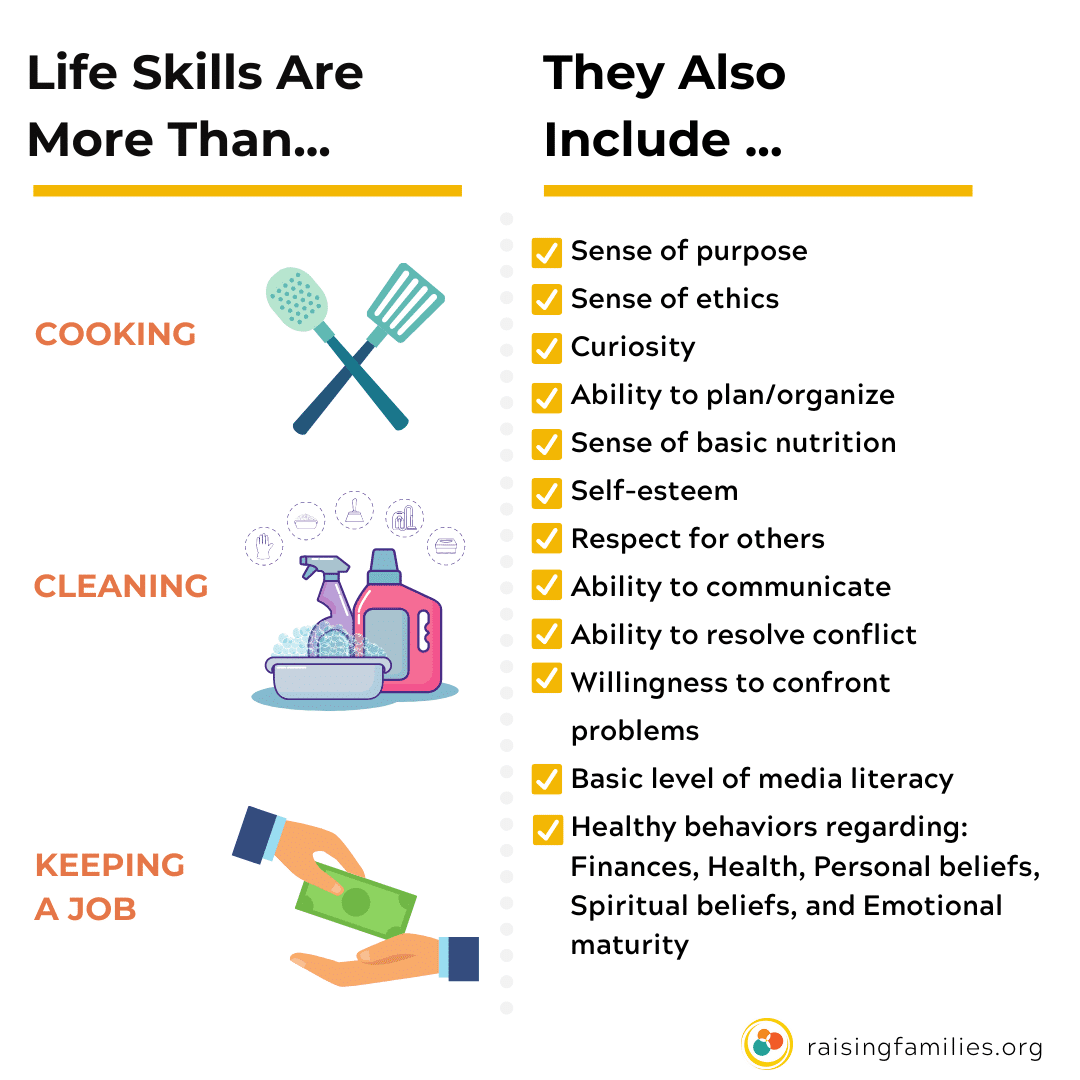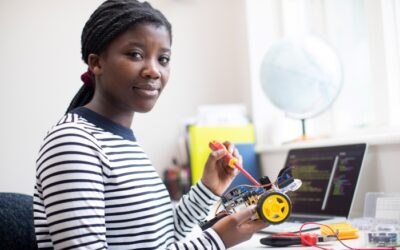If you’ve ever thought to yourself, raising kids is the best and worst job you’ve ever had, you’re certainly not alone. Guiding our children from tiny, helpless infants to self-sufficient adults is a monumental job requiring us to teach and model many important life skills.
If we are able to change our approach to how we parent over time, though, our job becomes much easier.
When we think about important life skills our children need, it’s not just a matter of the ability to cook, clean, and maintain a job. There are all sorts of other elements that take us from surviving to thriving members of society.

Enabling Our Kids with the Tools They Need
When our children are younger, we usually have a lot of resources to help us figure out what our kids need, like frequent well-child visits with Pediatricians.
But as our kids mature, we as parents have to stop being strictly providers and become enablers.
The sooner we recognize that our job as parents over time is to not figure everything out for our kids but rather, periodically shift gears and enable them with the tools to figure things out on their own, the better for all of us.
As enablers (in a good way), we work with our children to create opportunities to earn money, achieve other personal goals, organize their thinking, and consequently shape their self-perception and future prospects.
This is all done through our engagement.
Parent Engagement is the Key to Teaching Important Life Skills
To enable our kids with important life skills, we need to first have engagement.
For our purposes, engagement refers to how we interact with our kids, which includes but is not limited to the following list of behaviors (in no particular order):
- How we spend our time
- How we listen and how we talk to our children
- The traditions we maintain in the home
- How frequently we ask open-ended questions to encourage our child’s critical thinking and curiosity
- How often we invite cooperation and collaboration on everyday tasks
- Whether or not we are willing to honestly share mistakes we’ve made to show our own learning curve in life
- How often we explain our thought and decision-making processes when it comes to issues that concern the family
- How we earn respect rather than demand it and invite feedback without becoming defensive
- Whether or not we are willing to admit we don’t always have the answer and then work together to look it up or ask someone else for help
- How we encourage the process of exploration and learning, not just a winning end result
- Whether or not we prioritize the depth of connection and integrity of our long-term relationship over enforcing arbitrary rules
- How we apologize when we screw up
Engagement skills and style are all about the time we spend and the ways we show that we value our child’s well-being and the life-long relationship we’re building together.
Raising kids is challenging on so many levels. But the experience is filled with incredible opportunities.
Knowing what kind of engagement our kids need at different times in their life so that they can appropriately develop important life skills is also challenging.
Not only do you need to know what is appropriate for their stage of development but also you need to be able to change your approach over time from a parent to a coach and then to a mentor.
But when you know what’s coming next in their overall development, you know how to enable your child with the right tools, and you know how to engage with your child, the whole child-rearing process will be a lot smoother for the both of you.
How to Know What Comes Next
The Readiness Profile is an extremely powerful tool you can have at your disposal. All you have to do is look in The Readiness Profile beyond your child’s current age and see the capabilities you can help them develop.
The simple facts are that because no two children are exactly alike, they will develop at different rates.
However, at some point, they will all go through the same stages for their physical, cognitive, emotional, social, and life skills development.
The more we think about the future and use The Readiness Profile, the better we can do in deciding how best to make sure our limited time and engagement with our kids is appropriately focused.
Example 1: Helping Young Children Learn to Clean Up
Knowing that by age 6 our children should be able to keep their room organized and things put away WITHOUT your help, at 18 months we can start having them help with household tasks.
That will lead them to be able to help make their bed at 24 months, and by 3 years old, doing it all by themselves. That gets them prepared so that by age 6, their room is organized and things are put away without your help.
Example 2: Helping Older Kids Learn About Laundry
Seeing in the profile that by age 9 our children should have responsibilities in the home to complete, like laundry, at 18 months we can start having them help put their dirty clothes in the hamper after we help them get dressed.
They love to imitate and are eager to help at this age! Then when they’re 3 and dressing themselves, they’ll be able to put their dirty clothes in the hamper by themselves.
At age 3 while you’re folding clean laundry, you can also have them help you match socks and fold towels and help put it away. Then by age 7 they’ll be able to help fold the rest of the clean laundry and put it away.
By 8 you can show them how you wash the laundry and have them help. This will lead to them being able to do their own laundry by age 9 and put it away by themselves.
Example 3: Helping Teens Learn About Money
By age 18 our children should be able to develop a budget. To get to this point, at age 9 you can take your child in to open a saving account for money they get from an allowance and birthdays.
By 13 you can start discussing personal finances with your child and let them know your thoughts about money and help them manage their account.
If you’re comfortable with it, share the family’s finances with your child. Let them know how much goes toward bills and how much goes into savings each month.
When they’re 15 their savings and earnings can then be managed alone. Continue the discussion around money and let them know what things they’ll be responsible for paying on their own (e.g., gas when they use the family car once they have a license).
This experience will allow them to be able to create a budget of their own at 18.
Teaching Important Life Skills
By putting our engagement skills into practice at the right time based on The Readiness Profile, you’ll not only be teaching your child important life skills but also creating memories.
So, get your copy of The Readiness Profile here.
Then set aside a few minutes each week to do three things:
- Look at your child(ren)’s current age, and see how they are doing against the potential capabilities they can have at that age.
- Look to the future about where they’re headed.
- Make sure you spend quality time and interaction with them to help make sure they get to where they can be in the profile.
More Tools for Parents
Whatever age or stage your child is in, start now. If you’d like some more examples for how to build important life skills, take a look at Life Skills for Kids—Starting in Preschool to learn some other great ways to engage with your child.
For another take on what important life skills you should be teaching your child, take a look at Verywell Family’s article “11 Life Skills You Should Teach Your Kids.”
If you’re ready to really dive in, though, you’re going to want our guidebook Stop Calling Them Chores! that shares practical examples of how to model successful behavior, relevant developmental milestones that relate to building and maintaining good habits, how to have realistic conversations with your children, the steps you can take to help your child successfully develop respect for and care of themselves and their possessions, and strategies to introduce consequences (different than punishments).
By using the stages shown in The Readiness Profile and the examples shown in the Stop Calling Them Chores! guidebook, you’ll be able to look forward to see what’s coming next for your child and know how and when to engage with them to ensure they are enabled with the important life skills they’ll need to become successful independent adults.
Guidebook
The Readiness Profile
-
- A comprehensive guide to five fundamental areas of your child’s development from birth to age 18.
- Perfect for parents and caregivers looking for an integrated guide to child development focused on the whole child, not just one area at a time.
- Learn key details and actionable steps to promote physical, cognitive, emotional, social, and life skills development at any time from birth to age 18.
What To Do Next
1. Read more in the blog:
The Family Wisdom Blog shares valuable ideas across diverse topics.
2. Explore the Printables Library:
Our printables library is filled with must-have activity ideas, checklists, guides, and workbooks.
3. Subscribe to Our Newsletter:
Sign up for our newsletter for parenting tips to help you create the family team you've always wanted.
Somer Loomis
Somer is the Chief Content Officer at Raising Families, living in Southern California with her husband, nine-year-old son, and four-year-old daughter. She spent 10 years in the architecture field as a designer and medical planner, and now applies her love of integrative thinking and big-picture planning to her family and career.
In her free time, she loves cooking new recipes her children will never eat and saving craft projects on Pinterest she will likely never do. Nevertheless, she persists. Read full bio >>





